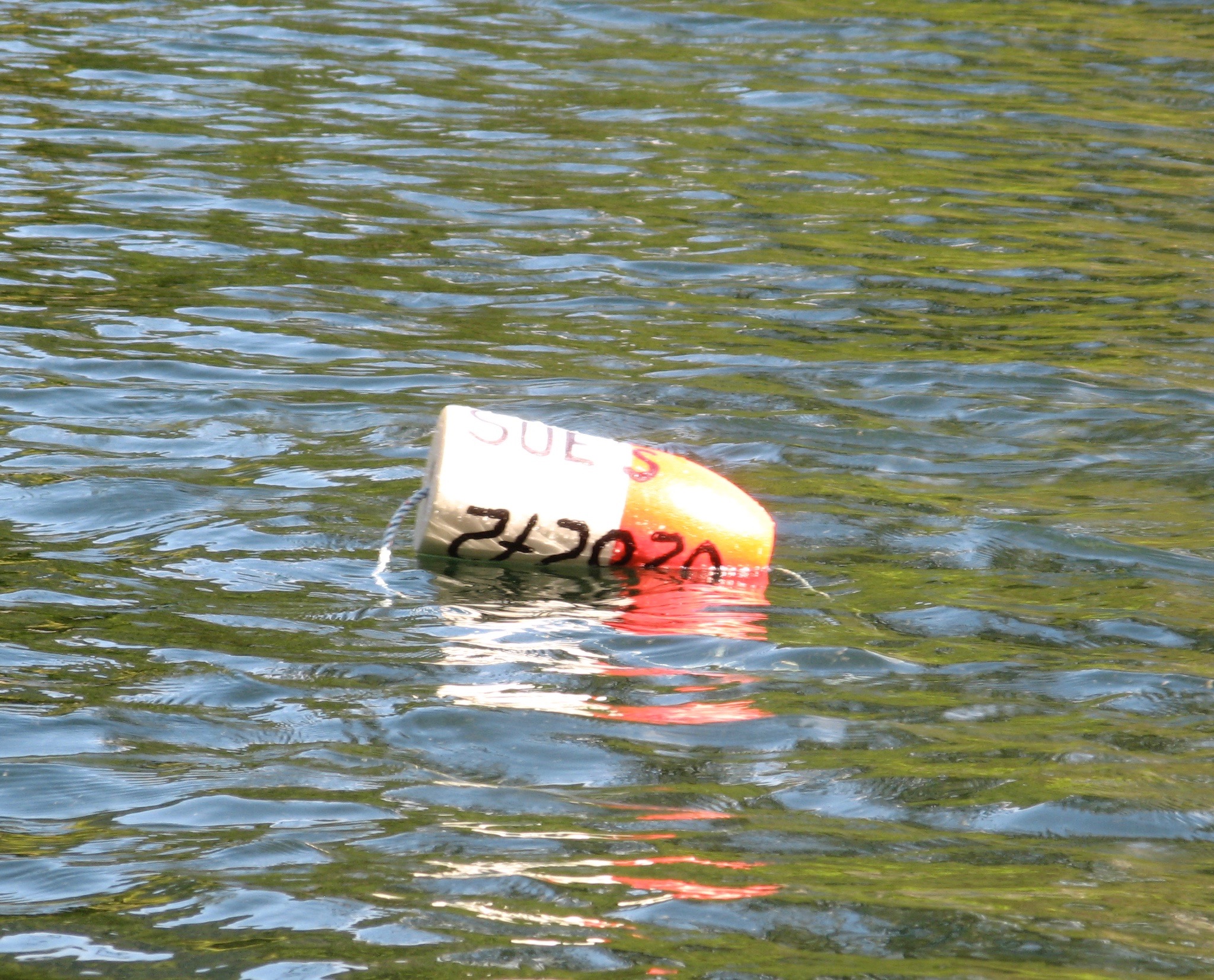How To Catch Fish and Trap Crabs – Part 2
There are no crabs in Desolation Sound!!! That’s what The First Mate has been told. How can there be no crabs? There’s every other kind of fish. What is there some kind of “Do not enter” sign out there that only crabs obey? This doesn’t make sense to her. So, she is going to crab.
.

Now in Desolation Sound anchored in Tenedos Bay, she clumsily rigs up her crab trap. For bait, she uses sliced bacon. The Captain is absolutely incredulous. That’s his breakfast going to the crabs! We drop the trap being careful not to drop it in an area deeper than her sinkable line (about 75 feet) or else that will be the end of crab trap, bait, line and float. Next morning – no crabs.
.
To appease The Captain over the unprecedented use of his bacon for crab bait, he is given a breakfast of bacon and eggs. He is somewhat mollified.
At the little convenience store in Gorge Bay where she finally found and purchased an 8 oz. weight, she is told that though there are no crabs in Desolation Sound, it is the season for prawns. Shrimp! We all like shrimp! Her one year license covers prawns, but she knows that no way can she ask The Captain to buy a prawn trap, bait (they like cat food) and 200 feet of sinkable line! With envy, she watches all the prawn traps from other boaters, as we glide by in Avante.
Two days later, we decide to try crabbing again. The word is that if any crab does head into Desolation Sound, he migrates to Okeover Bay. Shortly before arrival at the bay, she pulls the trap out of the aft locker. There’s a horrible smell. It’s the bacon from 2 days ago. There’s no way we can use that she thinks, but The Captain says that old and smelly is what crabs like. Politely, she contradicts him. “How to Catch Crabs” says that crabs are gourmands. The better the food, the bigger the crab. The bacon goes over the side with The Captain insisting that all the crabs, if any are around, will be screaming after that bacon. She fills the bait box with saved chicken fat and fish skins. Yum-m-m. Over the side it goes, and we go off to anchor elsewhere for lunch. Hours later – no crabs. The Captain gloats that that’s because all the crabs went after the free-floating bacon rather than the chicken fat in a dubious-looking mesh container.
.

Warner, who is no more a fisher person than The First Mate, decides to study her book: 103 Fishing Secrets to see if he can pick up on any worthwhile secrets.
.

We practice our fish line knots, following the drawings in “103 Fishing Secrets”. Got that down.
.

Using our newly acquired knot tying skills, we attach the flasher/spoon contraption that the fishermen on the dock in Victoria had rigged and given her. The weight is tied on, and the whole thing is thrown overboard. We are trolling for salmon. As the line is pulled behind our moving boat, The Captain, eyeing her clumsy endeavors, tells her to watch that she doesn’t get her fingers tangled in the line. “That is a good way to lose a finger.” She is not sure how to determine how much line is out, but eventually she decides that it is enough. She sits and waits for a fish to bite. As suspected, no self respecting fish would go after that thing.
Time is up. She reels in the line. The flasher can be seen flashing as it is being pulled through the water toward us. But, by the time it is back onboard the boat, the bright, shiny flashing meant to attract a fish has been abraded off. New flasher needed – $14.00.
At every opportunity, anyone who looks potentially knowledgeable of harvesting sea life is drilled about fishing and crabbing techniques. She is told that once we pass Campbell River and the Rapids (The Rapids? That’s another story), she will find crabs and fish. North of Port Hardy is even better. One kindly gentleman describes a bay across from Port Hardy where if we anchor at night, throw out a line, she’ll have a halibut by morning. Wow, that’s just what she is hoping for! She goes to bed dreaming of halibut.
The Captain wants to know if she knows what a halibut looks like. No, why should she? The closest she has come to a halibut is slices in a fish store. Out comes a book with a picture of a halibut, and it is not anybody’s idea of good looking! As she looks at the picture, she imagines her own creation story. Perhaps the First Nations people here in the Pacific Northwest would add it to their vast repertoire.
.

“When Mother Nature was into fish creating, she ran out of inspiration. After all, there are only so many things you can do with a basic fish shape. So she gave a lump of clay to her 3 year-old daughter and said, “Sweetie, make Mommy a fish”. She got what she asked for, and not wanting to squash her daughter’s budding creativity, she kept the thing. And that’s how Halibut came into being. Only she called it “forthehellofit” which changed, as words do over time, to Halibut.” (Origin Story: The Grun Tribe found in the vicinity of Telluride, Colorado)
She reads further that a halibut can weigh over 100 pounds. 100 pounds? That really isn’t something she wants at the end of her line. No, she thinks not. She is not greedy. At this moment, any ole fish will do as long as it meets the size limits, is edible, and she can get it in the boat!
